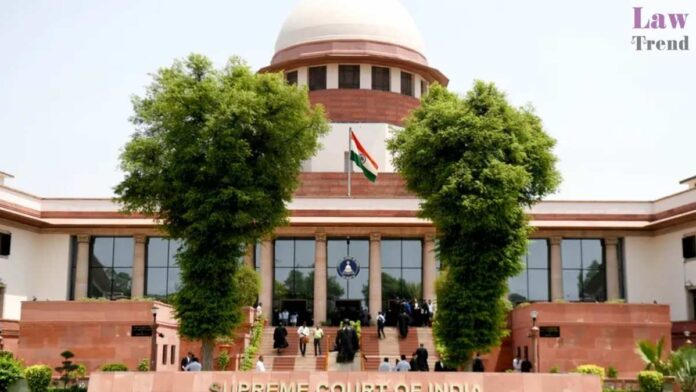The Supreme Court of India, in a judgment dated November 17, 2025, quashed an FIR in its entirety, including charges of dacoity under Section 310(2) of the Bharatiya Nyaya Sanhita, 2023 (BNS) [corresponding to Section 395 of the Indian Penal Code, 1860 (IPC)].
The Court, exercising its powers under Article 142 of the Constitution, set aside a Bombay High Court order that had refused to quash the dacoity charge despite an amicable settlement between the accused and the complainant.
A bench comprising Justice Vikram Nath and Justice Sandeep Mehta held that the “foundational element” of “dishonest intention” required to constitute theft, and by extension robbery or dacoity, was absent in the case. The Court found that the subsequent “complete restitution and amicable settlement” further diluted the allegation.
The appeal, Prashant Prakash Ratnaparki and Ors. v. The State of Maharashtra and Anr., challenged the High Court’s order dated January 31, 2025.
Background of the Case
The case stems from FIR C.R. No. 270 of 2024, registered at P.S. Nandurbar Taluka, District Nandurbar, based on a complaint by Rajendra Pura Rathod (Respondent No. 2), a Senior Clerk at P. G. Public School, Chowpale.
According to the FIR, on October 4, 2024, 6 to 7 unknown persons (the appellants) arrived at the school in two cars. The complainant alleged that the individuals entered the office, grabbed his mobile phone, pushed him, and grabbed his and another staff member’s collar, demanding to know where the “Engineering and B.A.M.S. files” were kept.
The complainant further alleged that one of the persons slapped him on the ear and forced them to open a cupboard. The individuals allegedly took a cheque book, blank letter pads of the organization (after forcing signatures and seals on the first two pages), Rs. 1.5 lakh in cash (stated as teacher’s salary), an additional Rs. 20,000 from a cash table, all organizational stamps, and an HP computer. They also located and took 5 to 6 B.A.M.S. files.
The FIR stated that the accused threatened to kill the Principal and “kidnap his children and students” if he reported the incident. Consequently, the FIR was registered for offences including those punishable under Sections 115(2) [Grievous Hurt], 351(2) [Criminal Intimidation], 351(3) [Intentional Insult], and 310(2) [Dacoity] of the BNS.
High Court’s Order and Subsequent Appeal
The accused-appellants filed a petition under Section 528 of the Bharatiya Nagarik Suraksha Sanhita, 2023 (BNSS) [corresponding to Section 482 CrPC] before the Bombay High Court, Aurangabad Bench, seeking to quash the FIR based on an amicable settlement with the complainant.
The High Court partially allowed the petition, quashing the offences under Sections 115(2), 351(2), and 351(3) of the BNS, viewing them as “personal to the complainant.”
However, the High Court refused to quash the proceedings for the offence of dacoity under Section 310(2) BNS. The High Court reasoned that dacoity “was not an offence personal to the complainant, as the alleged act had occurred within the premises of the school and pertained to its property,” and noted objections raised on behalf of the school. The appellants challenged this part of the order before the Supreme Court.
Supreme Court’s Analysis and Findings
The Supreme Court noted that the complainant (Respondent No. 2) had filed an affidavit before it, confirming an amicable settlement “upon intervention of the society members and elders.”
The complainant’s affidavit affirmed that the appellants had “returned all the money, blank cheque book, letter heads, stamps, files, and other materials belonging to the school.” It further stated that “no injury was caused to him or any other person” and that he was “not desirous of continuing with the prosecution.” The State of Maharashtra did not file a counter-affidavit.
Analyzing the FIR, the Supreme Court, in its judgment authored by Justice Mehta, observed that “the thrust of the allegations…is that the 6 to 7 unknown individuals had entered the premises of P.G. Public School in search of certain Engineering and B.A.M.S. files.”
The bench made the following key findings:
- Lack of ‘Dishonest Intention’: The Court held that the “foundational element of ‘theft’ as defined under Section 303 of the BNS [Section 378 of the IPC] is ‘dishonest intention'”. It found that the primary motive was not theft for wrongful gain. The judgment states: “The FIR itself discloses that the accused persons were primarily seeking access to specific institutional records…and had no intention to steal cash or property belonging to the institution.”
- Incidental Taking of Property: The Court viewed the alleged acts as “arising out of a dispute concerning possession of certain documents rather than from any intention to commit dacoity.” It observed that the “taking of cash, cheque books, and the computer appears incidental to this main purpose and not the primary object of the intrusion.”
- No Serious Violence: The Court also noted, “There is no allegation that the accused persons were armed with weapons or that they caused any serious injury to anyone.”
- Effect of Compromise and Restitution: The complainant’s affidavit confirming the return of all property and the settlement was deemed crucial. The Court held, “This complete restitution and amicable settlement between the accused and respondent No.2-complainant completely dilutes the allegation of ‘dishonest intention’ required to constitute theft, and by extension, robbery or dacoity.”
- Error in High Court’s Reasoning: The Supreme Court concluded that the High Court “erred” in sustaining the school’s objection and proceeding on the premise that the offence was not personal to the complainant who had settled the dispute.
- Inseparability of Offences: The Court found the High Court’s partial quashing to be unjustified, stating, “The factual matrix forming the basis of all the offences is inseparable and arises from a single transaction.” It held that the “compromise that was accepted as genuine and sufficient to quash the other offences equally dilutes the foundation of the charge of dacoity, which rests on the same set of allegations and circumstances.”
The Decision
Concluding that the “continued partial prosecution of the appellants for the offence of dacoity…is unjustified and deserves to be quashed,” the Supreme Court allowed the appeal.
“Thus, in exercise of our powers under Article 142 of the Constitution of India, we hereby quash the impugned FIR and all proceedings sought to be taken in furtherance thereof in entirety,” the Court ordered.







